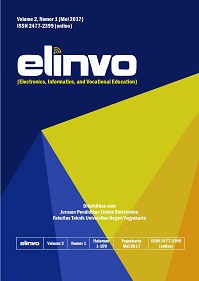Power Monitoring and Passenger Classification on Logistics Elevator
DOI:
https://doi.org/10.21831/elinvo.v6i2.43689Keywords:
Internet of Things, Logistics Lift, Real-Time Power MonitoringAbstract
The elevator has an important role in assisting transportation and logistics activities in a building. However, if the elevator is not used wisely, then the power consumption will be inefficient. A policy of elevator usage is necessary to ensure the effectiveness of elevator power consumption. Therefore, in this study, elevator power consumption monitoring is proposed. The power consumption behavior can be learned so a suitable policy can be made accordingly. Two elevators in Telkom Campus Surabaya are monitored to understand the daily electrical energy usage. Internet of Things (IoT) based real-time power monitoring system is used to monitor the electrical energy usage of the elevator. A raspberry pi is used to collect the data of electrical usage via a current and power sensor. The data is sent to the cloud, which later is displayed through a dashboard website. The result shows that the elevator usage on weekdays and weekends is different. The peak power on weekdays is obtained from 15.00 to 16.00, meanwhile, on weekends, the peak occurs from 9:00 to 10:00. On weekdays, the total power consumed by the elevator is 51.74kW, while on weekends, it is 11.94kW. Restrictions on the use of lifts are applied to periods when the lift has few passengers and has a short distance. From the results obtained, the total power consumed can decrease by an average of 37%. It is expected that the suggested policies can reduce elevator power consumption and the monthly cost of electrical energy.
References
M. Jain, T. Hoppe, and H. Bressers, "Analyzing sectoral niche formation: The case of net-zero energy buildings in India," Environ. Innov. Soc. Transitions, vol. 25, pp. 47–63, 2017.
J. Lizana, R. Chacartegui, A. Barrios-Padura, and J. M. Valverde, "Advances in thermal energy storage materials and their applications towards zero energy buildings: A critical review," Appl. Energy, vol. 203, pp. 219–239, 2017.
Z. Huang, Y. Lu, M. Wei, and J. Liu, "Performance analysis of optimal designed hybrid energy systems for grid-connected nearly/net zero energy buildings," Energy, vol. 141, pp. 1795– 1809, 2017.
Yan J, Chen B, Wennersten R, Campana P, Yang J. Cleaner energy for transition of cleaner city. Appl Energy 2017;196:97 9. https://doi.org/10.1016/j.apenergy. 2017.04.015.
Keirstead J, Jennings M, Sivakumar A. A review of urban energy system models: approaches, challenges and opportunities. Renew Sustain Energy Rev 2012;16(6):3847–66. https://doi.org/10.1016/j.rser.2012.02.047.
Morvaj B, Evins R, Carmeliet J. Decarbonizing the electricity grid: the impact on urban energy systems, distribution grids and district heating potential. Appl Energy 2017;191:125–40. https://doi.org/10.1016/j.apenergy.2017.01.058.
Alhamwi A, Medjroubi W, Vogt T, Agert C. Modelling urban energy requirements using open source data and models. Appl Energy 2018;231:11008. https://doi.org/ 10.1016/j.apenergy.2018.09.164.
Chen Y, Hong T, Piette MA. Automatic generation and simulation of urban building energy models based on city datasets for city-scale building retrofit analysis. Appl Energy 2017;205:323–35. https://doi.org/10.1016/j.apenergy.2017.07.128.
Pout CH. N-DEEM: The national nondomestic buildings energy and emissions model. Environ Plann B: Plann Des 2000;27(5):721–32. https://doi.org/10.1068/bst12.
Tukia T, Uimonen S, Siikonen M-L, Donghi C, Lehtonen M. High-resolution modeling of elevator power consumption. J Build Eng 2018;18:210–9. https://doi.org/ 10.1016/j.jobe.2018.03.008.
Smith RS, Peters RD, Al-Sharif L. Elevator system to minimize entrapment of passengers during a power failure, US patent 7,967,113 B2; 2011.
Fan G-F, Peng L-L, Hong W-C. Short term load forecasting based on phase space reconstruction algorithm and bi-square kernel regression model. Appl Energy 2018;224:13–33. https://doi.org/10.1016/j.apenergy.2018.04.075.
Yeo I-A, Yoon S-H, Yee J-J. Development of an urban energy demand forecasting system to support environmentally friendly urban planning. Appl Energy 2013;110:304–17. https://doi.org/10.1016/j.apenergy.2013.04.065.
Kersting WH. Distribution system modeling and analysis. Boca Raton, Florida, USA: CRC Press; 2002
Kurkcu A, Ozbay K. Estimating Pedestrian Densities, Wait Times, and Flows with Wi-Fi and Bluetooth Sensors. Transportation Research Record. 2017;2644(1):72-82. doi:10.3141/2644-09
M. A. Hannan et al., "A Review of Internet of Energy Based Building Energy Management Systems: Issues and Recommendations," in IEEE Access, vol. 6, pp. 38997-39014, 2018, doi: 10.1109/ACCESS.2018.2852811.
S. In Cho, "Vision-Based People Counter Using CNN-Based Event Classification," in IEEE Transactions on Instrumentation and Measurement, vol. 69, no. 8, pp. 5308-5315, Aug. 2020, doi: 10.1109/TIM.2019.2959853.
Tommaso Caldognetto, Enrico Mion, Mattia Bruschetta, Francesco Simmini, Ruggero Carli, Paolo Tenti, "A Model Predictive Approach for Energy Management in Smart Buildings", Power Electronics and Applications (EPE '19 ECCE Europe) 2019 21st European Conference on, pp. P.1 P.10, 2019.
Hong Fan, Jiayang Lu, Zuyi Li, Mohammad Shahidehpour, Shuqing Zhang, "Optimal Planning of Integrated Electricity-Gas System With Demand Side Management", Access IEEE, vol. 7, pp. 176790-176798, 2019.
Anh H. Vo, Le Hoang Son, Minh Thanh Vo, Tuong Le, "A Novel Framework for Trash Classification Using Deep Transfer Learning", Access IEEE, vol. 7, pp. 178631-178639, 2019.
M. A. Hannan et al., "A Review of Internet of Energy Based Building Energy Management Systems: Issues and Recommendations," in IEEE Access, vol. 6, pp. 38997-39014, 2018, doi: 10.1109/ACCESS.2018.2852811.
Downloads
Published
How to Cite
Issue
Section
Citation Check
License
The article published in ELINVO became ELINVO's right in publication.
This work by ELINVO is licensed under a Creative Commons Attribution-NonCommercial 4.0 International License.









